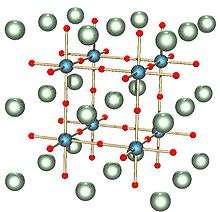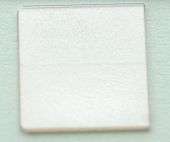Strontium titanate
 | |
| Names | |
|---|---|
| Systematic IUPAC name
Strontium(2+) oxotitaniumbis(olate) | |
| Other names
Strontium titanium oxide Tausonite | |
| Identifiers | |
| 3D model (JSmol) |
|
| ChemSpider | |
| ECHA InfoCard | 100.031.846 |
| EC Number | 235-044-1 |
| MeSH | Strontium+titanium+oxide |
| PubChem CID |
|
| |
| |
| Properties | |
| SrTiO 3 | |
| Molar mass | 183.49 g/mol |
| Appearance | White, opaque crystals |
| Density | 5.11 g/cm3 |
| Melting point | 2,080 °C (3,780 °F; 2,350 K) |
| insoluble | |
| Refractive index (nD) |
2.394 |
| Structure | |
| Perovskite | |
| Except where otherwise noted, data are given for materials in their standard state (at 25 °C [77 °F], 100 kPa). | |
| | |
| Infobox references | |
Strontium titanate is an oxide of strontium and titanium with the chemical formula SrTiO3. At room temperature, it is a centrosymmetric paraelectric material with a perovskite structure. At low temperatures it approaches a ferroelectric phase transition with a very large dielectric constant ~104 but remains paraelectric down to the lowest temperatures measured as a result of quantum fluctuations, making it a quantum paraelectric.[1] It was long thought to be a wholly artificial material, until 1982 when its natural counterpart—discovered in Siberia and named tausonite—was recognised by the IMA. Tausonite remains an extremely rare mineral in nature, occurring as very tiny crystals. Its most important application has been in its synthesized form wherein it is occasionally encountered as a diamond simulant, in precision optics, in varistors, and in advanced ceramics.
The name tausonite was given in honour of Lev Vladimirovich Tauson (1917–1989), a Russian geochemist. Disused trade names for the synthetic product include strontium mesotitanate, Fabulite,[2] Diagem, and Marvelite. Other than its type locality of the Murun Massif in the Sakha Republic, natural tausonite is also found in Cerro Sarambi, Concepción department, Paraguay; and along the Kotaki River of Honshū, Japan.[3][4]
Properties


Synthetic strontium titanate has a very large dielectric constant (300) at room temperature and low electric field. It has a specific resistivity of over 109 Ω-cm for very pure crystals.[5] It is also used in high-voltage capacitors. At high electron densities (achieved by doping) strontium titanate becomes superconducting below 0.35 K and was the first insulator and oxide discovered to be superconductive.[6] SrTiO3 has an indirect band gap of 3.25 eV and a direct gap of 3.75 eV.[7]
Strontium titanate is both much denser (specific gravity 4.88 for natural, 5.13 for synthetic) and much softer (Mohs hardness 5.5 for synthetic, 6-6.5 for natural) than diamond. Its crystal system is cubic and its refractive index (2.410—as measured by sodium light, 589.3 nm) is nearly identical to that of diamond (at 2.417), but the dispersion (the optical property responsible for the "fire" of the cut gemstones) of strontium titanate is 4.3x that of diamond, at 0.190 (B–G interval). This results in a shocking display of fire compared to diamond and diamond simulants such as YAG, GAG, GGG, Cubic Zirconia, and Moissanite.[3][4]
Synthetics are usually transparent and colourless, but can be doped with certain rare earth or transition metals to give reds, yellows, browns, and blues. Natural tausonite is usually translucent to opaque, in shades of reddish brown, dark red, or grey. Both have an adamantine (diamond-like) lustre. Strontium titanate is considered extremely brittle with a conchoidal fracture; natural material is cubic or octahedral in habit and streaks brown. Through a hand-held (direct vision) spectroscope, doped synthetics will exhibit a rich absorption spectrum typical of doped stones. Synthetic material has a melting point of ca. 2080 °C (3776 °F) and is readily attacked by hydrofluoric acid.[3][4]
At temperatures lower than 105 K, its cubic structure transforms to tetragonal.[8] Its monocrystals can be used as optical windows and high-quality sputter deposition targets.
SrTiO3 is an excellent substrate for epitaxial growth of high-temperature superconductors and many oxide-based thin films. It is particularly well known as the substrate for the growth of the lanthanum aluminate-strontium titanate interface. Doping strontium titanate with niobium makes it electrically conductive, being one of the only conductive commercially available single crystal substrates for the growth of perovskite oxides. Its bulk lattice parameter of 3.905Å makes it suitable as the substrate for the growth of many other oxides, including the rare-earth manganites, titanates, lanthanum aluminate (LaAlO3), strontium ruthenate (SrRuO3) and many others. Oxygen vacancies are fairly common in SrTiO3 crystals and thin films. Oxygen vacancies induce free electrons in the conduction band of the material, making it more conductive and opaque. These vacancies can be caused by exposure to reducing conditions, such as high vacuum at elevated temperatures.
High-quality, epitaxial SrTiO3 layers can also be grown on silicon without forming silicon dioxide, thereby making SrTiO3 an alternative gate dielectric material. This also enables the integration of other thin film perovskite oxides onto silicon.[9]
SrTiO3 has been shown to possess persistent photoconductivity where exposing the crystal to light will increase its electrical conductivity by over 2 orders of magnitude. After the light is turned off, the enhanced conductivity persists for several days, with negligible decay.[10][11]
Due to the significant ionic and electronic conduction of SrTiO3, it is potent to be used as the mixed conductor.[12]
Synthesis

Synthetic strontium titanate was one of several titanates patented during the late 1940s and early 1950s; other titanates included barium titanate and calcium titanate. Research was conducted primarily at the National Lead Company (later renamed N. L. Industries, Inc.) in the United States, by Leon Merker and Langtry E. Lynd. Merker and Lynd first patented the growth process on February 10, 1953; a number of refinements were subsequently patented over the next four years, such as modifications to the feed powder and additions of colouring dopants.
A modification to the basic Verneuil process (also known as flame-fusion) is the favoured method of growth. An inverted oxy-hydrogen blowpipe is used, with feed powder mixed with oxygen carefully fed through the blowpipe in the typical fashion, but with the addition of a third pipe to deliver oxygen—creating a tricone burner. The extra oxygen is required for successful formation of strontium titanate, which would otherwise fail to oxidize completely due to the titanium component. The ratio is ca. 1.5 volumes of hydrogen for each volume of oxygen. The highly purified feed powder is derived by first producing titanyl double oxalate salt (SrTiO(C2O4)2·2H2O) by reacting strontium chloride (SrCl2) and oxalic acid ((COOH)2.2H2O) with titanium tetrachloride (TiCl4). The salt is washed to completely eliminate chloride, heated to 1000 °C in order to produce a free-flowing granular powder of the required composition, and is then ground and sieved to ensure all particles are between 0.2–0.5 micrometres in size.[13]
The feed powder falls through the oxyhydrogen flame, melts, and lands on a rotating and slowly descending pedestal below. The height of the pedestal is constantly adjusted to keep its top at the optimal position below the flame, and over a number of hours the molten powder cools and crystallises to form a single pedunculated pear or boule crystal. This boule is usually no larger than 2.5 centimetres in diameter and 10 centimetres long; it is an opaque black to begin with, requiring further annealing in an oxidizing atmosphere in order to make the crystal colourless and to relieve strain. This is done at over 1000 °C for 12 hours.[13]
Thin films of SrTiO3 can be grown epitaxially by various methods, including pulsed laser deposition, molecular beam epitaxy, RF sputtering and atomic layer deposition. As in most thin films, different growth methods can result in significantly different defect and impurity densities and crystalline quality, resulting in a large variation of the electronic and optical properties.
Use as a diamond simulant
Its cubic structure and high dispersion once made synthetic strontium titanate a prime candidate for simulating diamond. Beginning ca. 1955, large quantities of strontium titanate were manufactured for this sole purpose. Strontium titanate was in competition with synthetic rutile ("titania") at the time, and had the advantage of lacking the unfortunate yellow tinge and strong birefringence inherent to the latter material. While it was softer, it was significantly closer to diamond in likeness. Eventually, however, both would fall into disuse, being eclipsed by the creation of "better" simulants: first by yttrium aluminium garnet (YAG) and followed shortly after by gadolinium gallium garnet (GGG); and finally by the (to date) ultimate simulant in terms of diamond-likeness and cost-effectiveness, cubic zirconia.[14]
Despite being outmoded, strontium titanate is still manufactured and periodically encountered in jewellery. It is one of the most costly of diamond simulants, and due to its rarity collectors may pay a premium for large i.e. >2 carat (400 mg) specimens. As a diamond simulant, strontium titanate is most deceptive when mingled with melée i.e. <0.20 carat (40 mg) stones and when it is used as the base material for a composite or doublet stone (with, e.g., synthetic corundum as the crown or top of the stone). Under the microscope, gemmologists distinguish strontium titanate from diamond by the former's softness—manifested by surface abrasions—and excess dispersion (to the trained eye), and occasional gas bubbles which are remnants of synthesis. Doublets can be detected by a join line at the girdle ("waist" of the stone) and flattened air bubbles or glue visible within the stone at the point of bonding.[15][16][17]
Use in radioisotope thermoelectric generators
Due to its high melting point and insolubility, strontium titanate has been used as a strontium-90-containing material in radioisotope thermoelectric generators, such as the US Sentinel and Soviet Beta-M series.[18][19]
References
- ↑ K. A. Muller & H. Burkard (1979). "SrTiO3: An intrinsic quantum paraelectric below 4 K". Phys. Rev. B. 19 (7): 3593–3602. Bibcode:1979PhRvB..19.3593M. doi:10.1103/PhysRevB.19.3593.
- ↑ Mottana, Annibale (March 1986). "Una brillante sintesi". Scienza e Dossier (in Italian). Giunti. 1 (1): 9.
- 1 2 3 "Tausonite". Webmineral. Retrieved 2009-06-06.
- 1 2 3 "Tausonite". Mindat. Retrieved 2009-06-06.
- ↑ "http://www.espimetals.com/index.php/technical-data/248-strontium-titanate", This link is broken, new reference needed
- ↑ Koonce, C. S.; Cohen, Marvin L. (1967). "Superconducting Transition Temperatures of Semiconducting SrTiO3". Phys. Rev. 163 (2): 380. Bibcode:1967PhRv..163..380K. doi:10.1103/PhysRev.163.380.
- ↑ K. van Benthem, C. Elsässer and R. H. French (2001). "Bulk electronic structure of SrTiO3: Experiment and theory". Journal of Applied Physics. 90: 6156. doi:10.1063/1.1415766.
- ↑ L. Rimai & G. A. deMars (1962). "Electron Paramagnetic Resonance of Trivalent Gadolinium Ions in Strontium and Barium Titanates". Phys. Rev. 127 (3): 702. Bibcode:1962PhRv..127..702R. doi:10.1103/PhysRev.127.702.
- ↑ R. A. McKee; F. J. Walker & M. F. Chisholm (1998). "Crystalline Oxides on Silicon: The First Five Monolayers". Phys. Rev. Lett. 81 (14): 3014. Bibcode:1998PhRvL..81.3014M. doi:10.1103/PhysRevLett.81.3014.
- ↑ "Persistent Photoconductivity in Strontium Titanate". Department of Physics and Astronomy, Washington State University, Pullman, Washington. Retrieved 2013-11-18.
- ↑ "Light Exposure Increases Crystal's Electrical Conductivity 400-fold [VIDEO]". Nature World News. Retrieved 2013-11-18.
- ↑ "Mixed conductors". Max Planck institute for solid state research. Retrieved 16 September 2016.
- 1 2 H. J. Scheel & P. Capper (2008). Crystal growth technology: from fundamentals and simulation to large-scale production. Wiley-VCH. p. 431. ISBN 3-527-31762-7.
- ↑ R. W. Hesse (2007). Jewelrymaking through history: an encyclopedia. Greenwood Publishing Group. p. 73. ISBN 0-313-33507-9.
- ↑ Nassau, K. (1980). Gems made by man. Santa Monica, California: Gemological Institute of America. pp. 214–221. ISBN 0-87311-016-1.
- ↑ O'Donoghue, M. (2002). Synthetic, imitation & treated gemstones. Great Britain: Elsevier Butterworth-Heinemann. pp. 34, 65. ISBN 0-7506-3173-2.
- ↑ Read, P. G. (1999). Gemmology, second edition. Great Britain: Butterworth-Heinemann. pp. 173, 176, 177, 293. ISBN 0-7506-4411-7.
- ↑ "Power Sources for Remote Arctic Applications" (PDF). Washington, DC: U.S. Congress, Office of Technology Assessment. June 1994. OTA-BP-ETI-129.
- ↑ Standring, WJF; Selnæs, ØG; Sneve, M; Finne, IE; Hosseini, A; Amundsen, I; Strand, P (2005), Assessment of environmental, health and safety consequences of decommissioning radioisotope thermal generators (RTGs) in Northwest Russia (PDF) (StrålevernRapport 2005:4), Østerås: Norwegian Radiation Protection Authority
